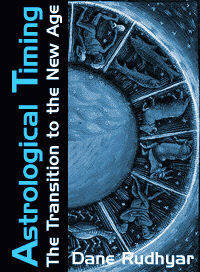 |
| Home | Bio | Art | Music | Literature | Civilization & Culture | Philosophy of Wholeness | Theosophy & Spirituality | Astrology |

ASTROLOGICAL TIMING
The Transition to the New Age by Dane Rudhyar, 1969 First published under the title Birth Patterns for a New Humanity
CONTENTS
PROLOGUE Where Do We Stand Today? PART ONE 1. Three Centuries of Crisis 2. Planetary Cycles 3. Cycles of Relationship PART TWO 4. Stars, Constellations and Signs of the Zodiac 5. From Buddha to Christ The Great Turning Point in Human Evolution Page 1 Page 2 The Beginning of the Piscean Age Page 3 Page 4 Page 5 The Broader Perspective Page 6 Page 7 A 100 BC Starting Point Page 8 Page 9 6. The Structure of the Piscean Age 7. At the Gates of the New Age 8. The Aquarius-Leo Age PART THREE 9. The Zodiacal Earth-Field 10. As We Face the Future EPILOGUE |

CHAPTER FIVE
From Christ to Buddha - 5 The concepts of "citizenship," of "person" (in a legal sense), or provincial administration, were really creations of the Roman mind. When they had been used before, it was with quite a different meaning — even in Greece. To these legalistic concepts deeply inbued with the Roman drive for administrative efficiency and the Roman pride — the pride of a "ruling race," to which the Anglo-Saxon culture has become heir — Christianity brought a spiritual dimension. Christ's idea that every man is a son of God, that Heaven (the formative power which makes of every person a microcosm of the whole universe) is within each human being, that the one ultimate and all-transforming "law" in the Law of universal Love, parallels at the level of the spirit the basic Roman concepts, even though these ideals of Christ are opposed to the exterior manifestations of the world of Caesar. In a very real sense, the Christian spiritual individualism needed the Roman concepts as earthly, concrete, social bases of operation. Jesus asked his disciples not to fight the Establishment symbolized by the Caesar-Image. He asked them to be "separate"; to go after his Father's business, to follow him even to the ultimate end, the Cross. The Hebrew world in which he had been born was divided in his time between the partisans of violent action and the upholders of what today we call "passive resistance" and "love-force" (or flower-power with the hippies — these early Christians without Christ). How strangely modern this situation! Does it not suggest that the two epochs, in some sense, are parallel? This has been, of course, Arnold Toynbee's contention in his monumental Study of History. The difficulty is a matter of exact timing. Does the crisis our modern world is facing, in Europe as well as America, somehow parallel that of the closing centuries of the Greco-Latin civilization? Has the new "Christianity" already come, in a not as yet too well-known form (the Bahai Faith perhaps?), and are we already at the "bread and circus" phase of the Roman Empire or just before a truly global Empire? Are already Washington and Moscow, the two West and East polarities of our modern technocratized world, facing the two billions of underfed and under-developed human beings kept at bay by our atomic bombs? Or are such attempts at synchronism and historical analogies most misleading? It is here that astrology can come in and state that there is a 2160-year cycle, and that it should be able to give at least a tentative answer to our problem. The reason it must remain tentative and somewhat inconclusive is that, I repeat, there is the possibility that the confluence of several cycles, small and very large, beginning at or close to our time, may precipitate certain processes. The interaction of the Neptune-Pluto cycles of some 493 years and the equinoctial cycle of 25,868 years may have accelerated, since 1892 (the Neptune-Pluto conjunction) the pace of events during the transition period between the so-called Piscean and Aquarian Ages. Above all, there is the possibility — to me, a strong probability — that the time at which the sidereal and tropical zodiacs coincided marked the beginning not only of one of the twelve precessional Ages but the beginning of a complete cycle of 25,868 years, a new Great Sidereal Year. If this is so, the meaning of the cyclic picture changes a great deal, for the events of 2000 years ago — and of this century and the next — are seen in a much broader perspective. By permission of Leyla Rudhyar Hill Copyright © 1969 by Dane Rudhyar and Copyright © 2001 by Leyla Rudhyar Hill All Rights Reserved.  Web design and all data, text and graphics appearing on this site are protected by US and International Copyright and are not to be reproduced, distributed, circulated, offered for sale, or given away, in any form, by any means, electronic or conventional. See Notices for full copyright statement and conditions of use. Web design copyright © 2000-2004 by Michael R. Meyer. All Rights Reserved. |
 |